Abstract
DNA polymorphisms in the glucokinase gene have recently been shown to be tightly linked to early-onset non-insulin-dependent diabetes mellitus in approximately 80% of French families with this form of diabetes. We previously identified a nonsense mutation in exon 7 in one of these families and showed that it was the likely cause of glucose intolerance in this dominantly inherited disorder. Here we report the isolation and partial sequence of the human glucokinase gene and the identification of two missense mutations in exon 7, Thr-228----Met and Gly-261----Arg, that cosegregate with early-onset non-insulin-dependent diabetes mellitus. To assess the molecular mechanism by which mutations at these two sites may affect glucokinase activity, the crystal structure of the related yeast hexokinase B was used as a simple model for human beta-cell glucokinase. Computer-assisted modeling suggests that mutation of Thr-228 affects affinity for ATP and mutation of Gly-261 may alter glucose binding. The identification of mutations in glucokinase, a protein that plays an important role in hepatic and beta-cell glucose metabolism, indicates that early-onset non-insulin-dependent diabetes mellitus may be primarily a disorder of carbohydrate metabolism.
Full text
PDF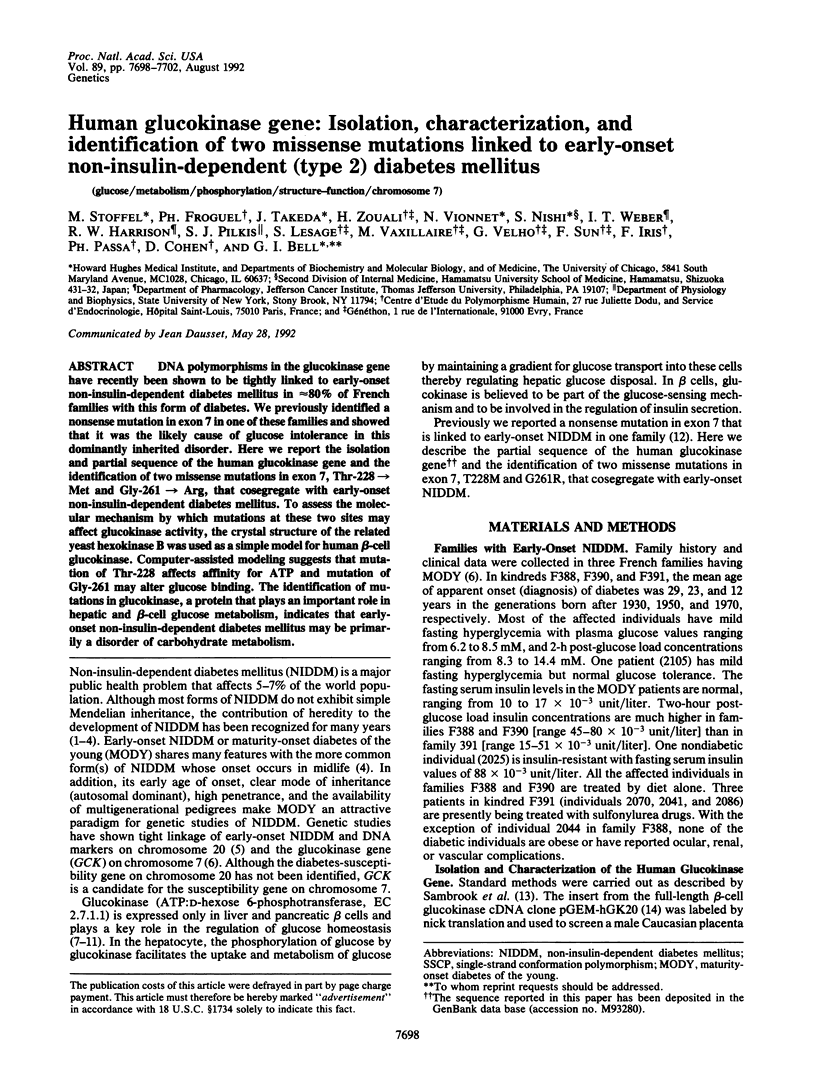
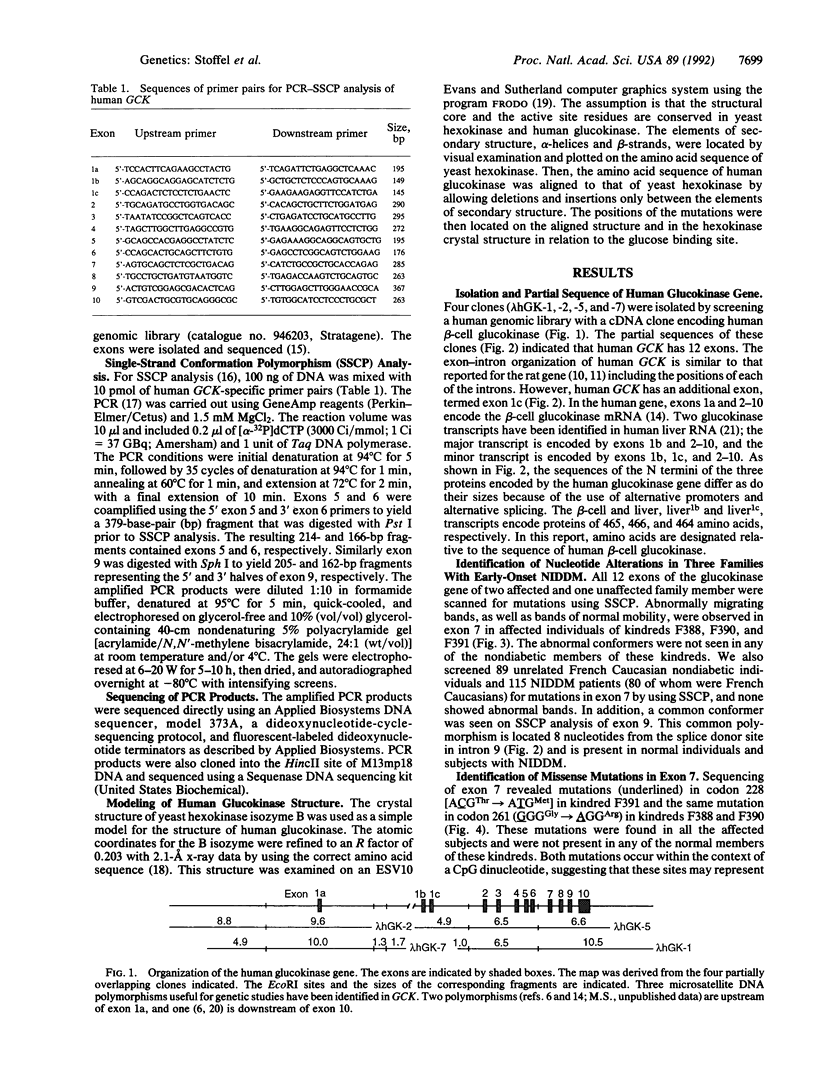
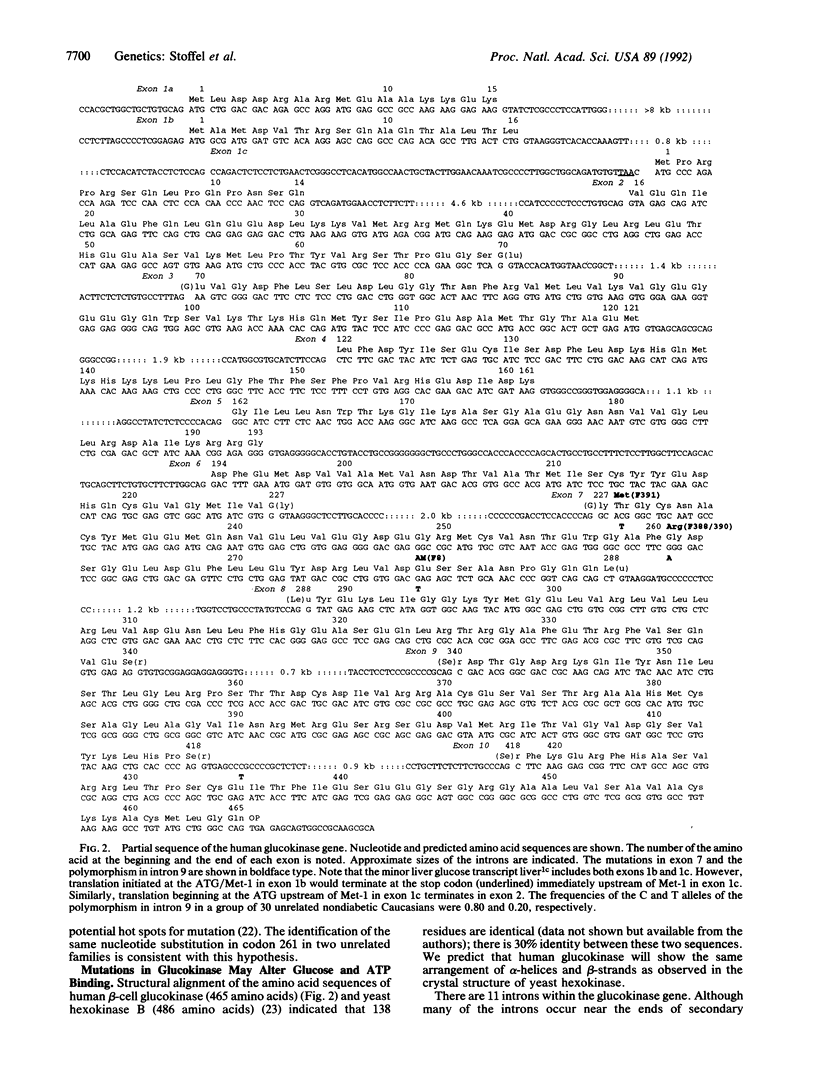
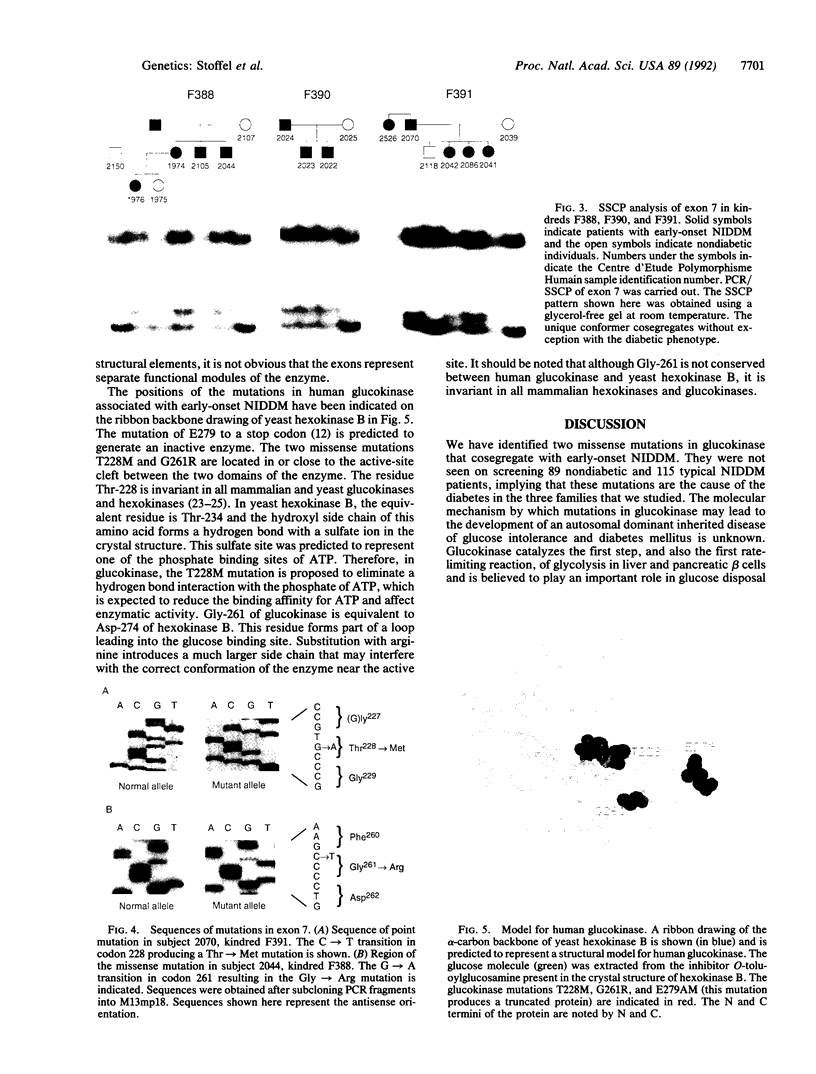
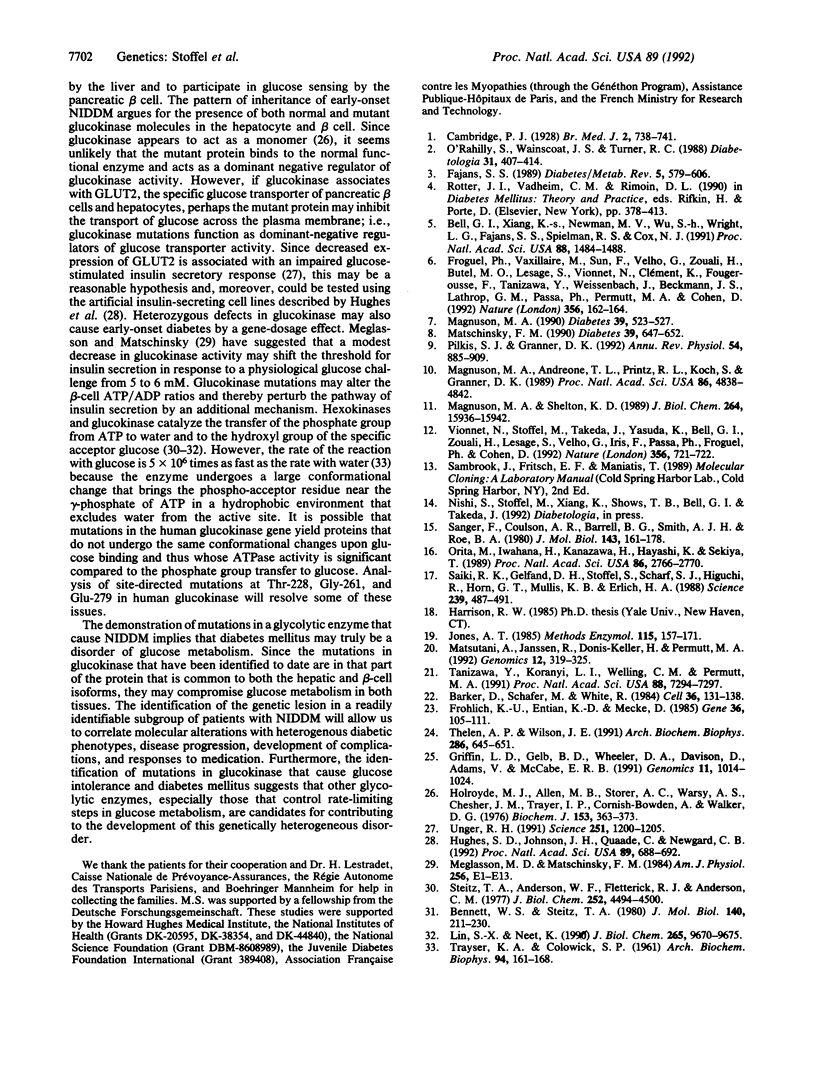
Images in this article
Selected References
These references are in PubMed. This may not be the complete list of references from this article.
- Barker D., Schafer M., White R. Restriction sites containing CpG show a higher frequency of polymorphism in human DNA. Cell. 1984 Jan;36(1):131–138. doi: 10.1016/0092-8674(84)90081-3. [DOI] [PubMed] [Google Scholar]
- Bell G. I., Xiang K. S., Newman M. V., Wu S. H., Wright L. G., Fajans S. S., Spielman R. S., Cox N. J. Gene for non-insulin-dependent diabetes mellitus (maturity-onset diabetes of the young subtype) is linked to DNA polymorphism on human chromosome 20q. Proc Natl Acad Sci U S A. 1991 Feb 15;88(4):1484–1488. doi: 10.1073/pnas.88.4.1484. [DOI] [PMC free article] [PubMed] [Google Scholar]
- Bennett W. S., Jr, Steitz T. A. Structure of a complex between yeast hexokinase A and glucose. II. Detailed comparisons of conformation and active site configuration with the native hexokinase B monomer and dimer. J Mol Biol. 1980 Jun 25;140(2):211–230. doi: 10.1016/0022-2836(80)90103-5. [DOI] [PubMed] [Google Scholar]
- Fajans S. S. Maturity-onset diabetes of the young (MODY). Diabetes Metab Rev. 1989 Nov;5(7):579–606. doi: 10.1002/dmr.5610050705. [DOI] [PubMed] [Google Scholar]
- Fröhlich K. U., Entian K. D., Mecke D. The primary structure of the yeast hexokinase PII gene (HXK2) which is responsible for glucose repression. Gene. 1985;36(1-2):105–111. doi: 10.1016/0378-1119(85)90074-5. [DOI] [PubMed] [Google Scholar]
- Griffin L. D., Gelb B. D., Wheeler D. A., Davison D., Adams V., McCabe E. R. Mammalian hexokinase 1: evolutionary conservation and structure to function analysis. Genomics. 1991 Dec;11(4):1014–1024. doi: 10.1016/0888-7543(91)90027-c. [DOI] [PubMed] [Google Scholar]
- Holroyde M. J., Allen M. B., Storer A. C., Warsy A. S., Chesher J. M., Trayer I. P., Cornish-Bowden A., Walker D. G. The purification in high yield and characterization of rat hepatic glucokinase. Biochem J. 1976 Feb 1;153(2):363–373. doi: 10.1042/bj1530363. [DOI] [PMC free article] [PubMed] [Google Scholar]
- Hughes S. D., Johnson J. H., Quaade C., Newgard C. B. Engineering of glucose-stimulated insulin secretion and biosynthesis in non-islet cells. Proc Natl Acad Sci U S A. 1992 Jan 15;89(2):688–692. doi: 10.1073/pnas.89.2.688. [DOI] [PMC free article] [PubMed] [Google Scholar]
- Jones T. A. Diffraction methods for biological macromolecules. Interactive computer graphics: FRODO. Methods Enzymol. 1985;115:157–171. doi: 10.1016/0076-6879(85)15014-7. [DOI] [PubMed] [Google Scholar]
- Magnuson M. A., Andreone T. L., Printz R. L., Koch S., Granner D. K. Rat glucokinase gene: structure and regulation by insulin. Proc Natl Acad Sci U S A. 1989 Jul;86(13):4838–4842. doi: 10.1073/pnas.86.13.4838. [DOI] [PMC free article] [PubMed] [Google Scholar]
- Magnuson M. A. Glucokinase gene structure. Functional implications of molecular genetic studies. Diabetes. 1990 May;39(5):523–527. doi: 10.2337/diab.39.5.523. [DOI] [PubMed] [Google Scholar]
- Magnuson M. A., Shelton K. D. An alternate promoter in the glucokinase gene is active in the pancreatic beta cell. J Biol Chem. 1989 Sep 25;264(27):15936–15942. [PubMed] [Google Scholar]
- Matschinsky F. M. Glucokinase as glucose sensor and metabolic signal generator in pancreatic beta-cells and hepatocytes. Diabetes. 1990 Jun;39(6):647–652. doi: 10.2337/diab.39.6.647. [DOI] [PubMed] [Google Scholar]
- Matsutani A., Janssen R., Donis-Keller H., Permutt M. A. A polymorphic (CA)n repeat element maps the human glucokinase gene (GCK) to chromosome 7p. Genomics. 1992 Feb;12(2):319–325. doi: 10.1016/0888-7543(92)90380-b. [DOI] [PubMed] [Google Scholar]
- Meglasson M. D., Matschinsky F. M. New perspectives on pancreatic islet glucokinase. Am J Physiol. 1984 Jan;246(1 Pt 1):E1–13. doi: 10.1152/ajpendo.1984.246.1.E1. [DOI] [PubMed] [Google Scholar]
- O'Rahilly S., Wainscoat J. S., Turner R. C. Type 2 (non-insulin-dependent) diabetes mellitus. New genetics for old nightmares. Diabetologia. 1988 Jul;31(7):407–414. doi: 10.1007/BF00271584. [DOI] [PubMed] [Google Scholar]
- Orita M., Iwahana H., Kanazawa H., Hayashi K., Sekiya T. Detection of polymorphisms of human DNA by gel electrophoresis as single-strand conformation polymorphisms. Proc Natl Acad Sci U S A. 1989 Apr;86(8):2766–2770. doi: 10.1073/pnas.86.8.2766. [DOI] [PMC free article] [PubMed] [Google Scholar]
- Pilkis S. J., Granner D. K. Molecular physiology of the regulation of hepatic gluconeogenesis and glycolysis. Annu Rev Physiol. 1992;54:885–909. doi: 10.1146/annurev.ph.54.030192.004321. [DOI] [PubMed] [Google Scholar]
- Saiki R. K., Gelfand D. H., Stoffel S., Scharf S. J., Higuchi R., Horn G. T., Mullis K. B., Erlich H. A. Primer-directed enzymatic amplification of DNA with a thermostable DNA polymerase. Science. 1988 Jan 29;239(4839):487–491. doi: 10.1126/science.2448875. [DOI] [PubMed] [Google Scholar]
- Sanger F., Coulson A. R., Barrell B. G., Smith A. J., Roe B. A. Cloning in single-stranded bacteriophage as an aid to rapid DNA sequencing. J Mol Biol. 1980 Oct 25;143(2):161–178. doi: 10.1016/0022-2836(80)90196-5. [DOI] [PubMed] [Google Scholar]
- Steitz T. A., Anderson W. F., Fletterick R. J., Anderson C. M. High resolution crystal structures of yeast hexokinase complexes with substrates, activators, and inhibitors. Evidence for an allosteric control site. J Biol Chem. 1977 Jul 10;252(13):4494–4500. [PubMed] [Google Scholar]
- TRAYSER K. A., COLOWICK S. P. Properties of crystalline hexokinase from yeast. II. Studies on ATP-enzyme interaction. Arch Biochem Biophys. 1961 Jul;94:161–168. doi: 10.1016/0003-9861(61)90024-8. [DOI] [PubMed] [Google Scholar]
- Tanizawa Y., Koranyi L. I., Welling C. M., Permutt M. A. Human liver glucokinase gene: cloning and sequence determination of two alternatively spliced cDNAs. Proc Natl Acad Sci U S A. 1991 Aug 15;88(16):7294–7297. doi: 10.1073/pnas.88.16.7294. [DOI] [PMC free article] [PubMed] [Google Scholar]
- Thelen A. P., Wilson J. E. Complete amino acid sequence of the type II isozyme of rat hexokinase, deduced from the cloned cDNA: comparison with a hexokinase from novikoff ascites tumor. Arch Biochem Biophys. 1991 May 1;286(2):645–651. doi: 10.1016/0003-9861(91)90094-y. [DOI] [PubMed] [Google Scholar]
- Unger R. H. Diabetic hyperglycemia: link to impaired glucose transport in pancreatic beta cells. Science. 1991 Mar 8;251(4998):1200–1205. doi: 10.1126/science.2006409. [DOI] [PubMed] [Google Scholar]
- Vionnet N., Stoffel M., Takeda J., Yasuda K., Bell G. I., Zouali H., Lesage S., Velho G., Iris F., Passa P. Nonsense mutation in the glucokinase gene causes early-onset non-insulin-dependent diabetes mellitus. Nature. 1992 Apr 23;356(6371):721–722. doi: 10.1038/356721a0. [DOI] [PubMed] [Google Scholar]






